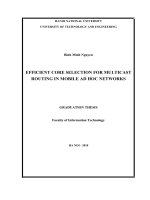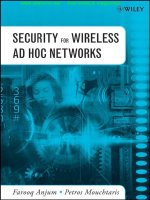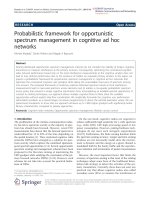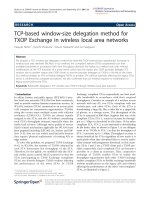Time dependent finite state machine based method for intrusion detection in mobile ad hoc networks
Bạn đang xem bản rút gọn của tài liệu. Xem và tải ngay bản đầy đủ của tài liệu tại đây (737.54 KB, 8 trang )
International Journal of Computer Networks and Communications Security
C
VOL. 2, NO. 8, AUGUST 2014, 242–249
Available online at: www.ijcncs.org
ISSN 2308-9830
N
C
S
Time Dependent Finite State Machine based Method for Intrusion
Detection in Mobile Ad Hoc Networks
MAHDA NOURA1, SINA MANAVI2, NASRIN KHANEZAEI3
1, 2, 3
Faculty of Computer Science and IT, U.P.M. University, Kuala Lumpur, Malaysia
E-mail: , ,
ABSTRACT
The Ad hoc On-Demand Distance Vector (AODV) routing protocol designed with the purpose of mobile ad
hoc networks has numerous advantages such as low network utilization, fast adjustments to link conditions
and low memory and processing overheads. However, if security is not considered in this protocol it is at
risk to many attacks. The conventional methods such as firewalls, encryption is no longer adequate. In this
paper, we identify three types of threats against AODV which influence the routing message in MANET.
Our solution is based on the use of Time based Finite State Machine to identify correct and malicious
behavior in AODV. The TFSM have been modelled using JFLAP and simulated in MANET environment
using C#.
Keywords: AODV, MANET, Intrusion Detection, Time Finite State Machine, Automata, JFLAP, C#.
1
INTRODUCTION
Mobile Ad Hoc Networks (MANETs) is known
as a collection of wireless computers with
communication between them which are able to
move freely without any dependency on the
infrastructures. Base stations or access points are
great examples of such independent mobile systems
[1]. In the MANET, nodes forward the packets
among each other, to contribute the routing
functionality and provide indirect wireless
transmission; acting as both hosts and routers.
Since MANET is a decentralized administration
and does not need a fixed network infrastructure, it
can be set up quickly and inexpensively on demand,
it can be applied in different scenarios such as
military applications [2], [3], emergent application
[4], [5], and Personal Digital Assistants (PDAs) [6],
civilian application like an ad-hoc meeting or ad
hoc classrooms. De Morais Cordeiro discussed
deeper about mobile ad hoc network applications
and their theory in his book [7].
While wired networks are strongly secure in
gateways and routers, MANET security challenges
raise due to its dynamic nature, significant
dependency to node cooperation, lack of centralized
administration [8], [9]. Since MANET’s topology is
progressing and growing, there is no standard
defined boundary, consequently, firewall access
control mechanism cannot be applied properly on
such networks. On the other hand, crypto systems
cannot be applied on it due to lacks of centralized
administration, which allow a malicious user to
take control of the whole network. Increasing the
number of nodes in this network requires to provide
higher level of security [10]. To Identify the
malicious user and intrusion over the network,
MANET needs a precise security mechanism. This
research has focused on dropping attack, resource
consumption and sequence number attack. The
propose method in this study is based on Time
based Finite State Machine (TFSM) for Intrusion
Detection System (IDS) using JFLAP software to
detect attacks on the Ad Hoc On-demand Distance
Vector (AODV) routing protocol. To identify the
aforementioned attack types, the AODV, it is
implemented in MANET.
The Rest of this work is organized as follows:
background of IDS, AODV security, and IDS over
the ad hoc networks has been reviewed in section
II. In Section III, three vulnerabilities of MANET
and AODV have been discussed. The proposed
TFSM model is given in section 4. The 5th section,
illustrates the AODV model with the JFLAP
software, and implemented simulation software has
been demonstrated by the research. The last section,
243
M. Noura et. al / International Journal of Computer Networks and Communications Security, 2 (8), August 2014
conclude the research and discuss about future
works of this criteria.
2
BACKGROUND
2.1 Intrusion Detection System (IDS)
Intrusion are defined as any malicious activity
which compromise the availability, confidentiality
or integrity of computer resources in digital world
[11] and to detect these intrusion, Intrusion
Detection System is proposed. Data collection,
detection and response are the three main
components of the IDS. The first component in IDS
is known as data collection that is responsible to
collect and basic processes such as data transfer to
the standard format, store and replicate them to the
detection modules [11].
The input data sources for the IDS can vary from
system logs, network packets and etc. detection
components is another key feature of the IDS to
analysis the received information from data
collection components and detect the possible
intrusions. And finally once this component
identifies any intrusions, it sends them to the
response component. Intrusion Detection System is
applicable for vulnerability scanning and
assessments. It utilize two common techniques
signature based detection and anomaly based
detection [12].
Signature based IDS monitors regarding
behaviors that match predefined patterns which
define a known threat. A key benefit of this method
is that creating and understanding signatures are
simple when we know what network activities we
are trying to identify [13]. There is an attack
signature database that keeps record of all the
different types of attacks that may occur on the
network. Anytime a sensor sends information down
on to the collector it will compare that information
against the attack database and if it finds a match it
knows that the system is under attack. However, if
there is no match it is going to assume that
everything is normal. They can’t identify an attack
they do not know about.
In an anomaly based system there is a network
history database instead of an attack database. A
network history database collects information about
normal behavior in the network and overtime it
establishes relatively accurate baseline of what
regular behavior is. Then anytime there is a
deviation from normal behavior it would be
compared against the baseline and a determination
would be made as to whether or not that an attack
has occurred [12], [13].
One of the disadvantages of anomaly based is
that there is a potential for more false positives
because of the fact that it is not locked in an
absolute signature of attack. It’s looking at
behaviors on the network and there is a chance that
what might be normal behavior may be
misunderstood as an attack and some false positives
may occur. An upshot to anomaly based is the fact
that it is not locked down to a signature database.
And finally the last response component once
alarmed by the previous component, act based on
the response policy actively or passively. An active
response IDSs is used to take some kind of action
automatically in response to a suspicious activity in
order to stop the attack at the entry point. The
action depends on the critically of the attack. It can
communicate with the networking devices and can
send meaningful instructions to those devices in
order to be able to get to do something to block
that. One active response is gathering extra
information about the suspicious attack and the
intruder by the increasing the sensitivity level of an
IDS. Another active response is to stop an attack
and subsequently block further access of the
intruder to the system. This could be done by
changing the configuration of firewall and routers.
Another active response is invasion back which is
illegal and launches attacks against the intruder.
A passive IDPS is a system that is designed to
monitor and analyze activities of network traffic
and inform other parties about the occurrence of an
attack. A passive IDPS does not automatically
respond to an intrusion and relies on human
interventions like a system administrator to respond
to the alarm, take a suitable action to stop the
attack. Some IDS, simply log suspicious activities
in a log file and the system administrator would be
informed for example by email or pager. Alarms
and notifications varies widely, ranging from an
onscreen alert, email, pager, cellular phones to
SNMP trap messages and plug-ins.
2.2 Intrusion Detection Issues in MANETS
Wireless Links: eavesdropping attack is one of
the vulnerability which takes place due to the use of
wireless links in MANETs. While in the wired
attack, intruder requires to have a physical access,
in MANETs, he can compromise the system
without any physical access. Another disadvantage
of the wireless networks is low bandwidth; as a
result, by consuming the bandwidth by the
malicious user, authorized nodes may lose their
accessibility and normal communication [11].
Dynamic Topology: the main reason that network
topology changes frequently is that, MANET nodes
can freely move from one network to another, leave
or joint another network. Thus this dynamic
environment brings difficulties in differentiating the
244
M. Noura et. al / International Journal of Computer Networks and Communications Security, 2 (8), August 2014
abnormal behaviour from normal behaviour.
Moreover, all the nodes has
the mobility
characteristic, and servers neither other critical
nodes are exception, therefore these critical nodes
are not as well as wired critical nodes, in a locked
place which increases the risk of being
compromised [11].
Cooperativeness: since mostly in MANET nodes
are assumed as cooperative and non-malicious,
malicious attacker easily can take control the
network as a routing agent and disrupt the network
operations [14].
Lack of clear line of defence: MANETS can be
under attack from all direction, because there is no
clear line of defence in MANET. On the other
hand, there is no boundary to separate the inside
network from outside world. Meaning there is no
defined area for monitoring the traffic and applying
access control mechanisms. Unlike Wired networks
that all network packets pass from gateways,
routers or switches, MANET network data is
distributed in the transmission range [14].
Limited Resources: MANET support different
type of devices from laptops to mobile phones and
PDAs with different computing power and storage
capacities. The mobile nodes can be alive by the
battery’s power, which attracts attackers to develop
new type of attack targeting the power consumption
called Sleep Deprivation Torture”. Applying the
new security mechanism to protect these networks
from such attacks itself, demands more computing
and communication resources. This is another
problem that rise in MANET networks [14].
2.3 Overview of AODV protocol
Many routing protocols have been introduced to
suit the diverse needs of MANETs. In this section
we will explain how AODV works to understand
better the routing attacks which are later explained.
There are three main types of messages in AODV:
route request (RREQ), route reply (RREP), and
route error (RERR) messages. At first, when a node
wants to communicate with another node in the
network and does not have a fresh route to this
destination, it starts the route discovery process by
broadcasting a RREQ message for the destination
node into the network. Intermediate nodes that
receive this request either send a RREP to the
source node if they have a fresh route to the
destination node and the "destination only" flag is
not set, or forward the RREQ message to other
nodes. A fresh route is a valid route entry whose
sequence number is equal to or greater than that
contained in the RREQ message. If the request
packet has been forwarded by this intermediate
node before, the RREQ message is dropped. When
the destination node receives a RREQ for itself, it
sends back a RREP message on the reverse route.
The node which initiated the request and the nodes
which received the RREP messages on the route
update their routing tables with the new route. Fig
1, demonstrates the visualized concept of AODV.
Fig. 1. AODV Concept
3 ATTACKS ON MANETS AND AODV
PROTOCOL
MANET security just similar to other networks
relies on authentication, confidentiality, integrity,
availability and non-reputation [15]. To verify the
identity of the source information, authentication
mechanism is applied to verify the identification of
source information. To avoid any unauthorized
access to the resources, confidentiality mechanism
is applied. To provide the on demand accessibility
to the nodes and resources by the authorized user,
availability mechanism is provided. Denial of
Service (DoS) attack is one attack against
availability. Lastly, non-repudiation ensures that the
actions that are done by someone cannot be denied.
In MANETs security objectives can vary in
different modes and situation (e.g. war time, peace
time etc.). MANETs characteristics make them
vulnerable to net attacks. Here we will focus on
active attacks that exist in MANET such as
sequence number attack, dropping attack and
resource consumption attack.
3.1 Sequence Number Attack
In AODV protocol routes are created and
maintained by assigning increasing sequence
numbers to routes for a particular destination.
Because a fresh route is determined by the
destination sequence number and indeed fresh
routes are better, a malicious node can send
incorrect routing information to the network. When
the malicious node receives a RREQ even if it does
not have a fresh route in its routing table it creates a
RREP with fake information about the sequence
number and the next hop. The malicious node puts
a high number to the destination sequence number
245
M. Noura et. al / International Journal of Computer Networks and Communications Security, 2 (8), August 2014
in order for the fake information to be chosen. If the
RREP from the malicious node is received before
the one from the legitimate source node then the
malicious node will be put in the route. Therefore,
it can capture the routing packets or perform a
black hole attack. Even if the RREP of the
legitimate node is received first, finally it will reach
and because the destination sequence number is
bigger than the original route it will be replaced by
the incorrect route.
3.2 Dropping Attack
Malicious or selfish nodes intentionally drop all
the packets that are not destined for them. The aim
of selfish nodes is to reserve their resources. If the
dropping node is at an important location dropping
attacks can avoid end-end communication between
nodes. It may also reduce the network performance
by causing packets to be retransmitted, new route
discovery and so on. Except DSR protocol, most of
the routing protocols are unable to identify whether
data packets have been forwarded by intermediate
nodes or not. But, attacks against a node can be
identified through passive acknowledgements by its
neighbour [11].
3.3 Resource Consumption Attack
In this kind of attack, malicious user targets the
MANET by sending the pointless routing traffic
such as PREQ and RERR packets to flood the
network bandwidth with the false and irrelevant
routing packets. Thus consuming the energy and
processing power of the nodes.
4
TIME BASED FINITE STATE MACHINE
DETECTION FOR AODV
The time-dependent Finite State Machine is an
extension to FSM. In any TFSM a time interval is
considered between receiving inputs in order to
identify a member of a language. Using TFSM is
extremely valuable when identifying threats in a
network because many threats rely on the duration
between the arrivals of packets. In the following the
design of the TFSM related to the detection of three
types of attacks have been deliberated.
4.1 Sequence number attack
In order to identify the sequence number attack
correctly two different TFSMs are required.
In Fig2 the TFSM is triggered whenever a node
initiates a route discovery process. If a RREP
message does not arrive within a predefined time
period (Time-Out) the TDFA timeouts and resets to
its initial state (init_0). When the first RREP
message is received the machine checks if the
included destination sequence number (RREP-destseq) is much higher than the sequence number
which is in the RREQ (origin-dest-seq). If it is very
high it goes directly to the alarm state (Alarm). If it
is not, it stays in the same state (state 1) for time t.
If the timer expires without receiving another
RREP it goes to the accept state. If within the time
limit another RREP(s) arrives, destination sequence
number is checked to see if it is valid, similarly a
decision is taken whether to move to an alarm state.
When an alarm occurs the source node knows that
the information in the RREP is forged and that it
must not update the routing table with the invalid
routing information. The machine goes to the state
0 when the sender initiates a RREQ.
Fig. 2. Initiating a route discovery process
246
M. Noura et. al / International Journal of Computer Networks and Communications Security, 2 (8), August 2014
Fig. 3. Protecting the intermediate nodes
The second TFSM (Fig 3) for this attack protects
the intermediate nodes that receive the RREQ
initiated for the source node. When an intermediate
node receives a RREQ there are 2 actions that can
be taken:
•
The intermediate node itself has a fresh
enough route to the destination. In this case it sends
a RREP message and the TFSM moves to accept
state (state 4).
•
The intermediate node does not have the
necessary information to reply to this RREQ. In this
case it forwards the RREQ packet downstream and
moves to state 2. The TFSM stays in this state for
time t. If the timer expires it moves to the initial
state and resets. If it receives a RREP before the
timeout, it moves to state 3. In state it must check to
see whether the sequence number is valid or not. It
is the same as the previous TFSM. If the sequence
number is acceptable within the time limits it goes
to accept state. Otherwise, it should go to the Alarm
state and should not add this fake route to its
routing table. The intermediate node cannot drop
the RREP message even though it has recognized a
forgery. Thus in the Alarm state the RREP message
is sent to the initial node.
4.2 Dropping Routing Packet
The neighboring nodes can identify whether a
malicious node has forwarded a routing packet.
However, there is a challenge because the
neighboring node may have not forwarded the
packet due to traffic overload and this will produce
false alarm. So, at first it is moved to a pre-alarm
state and in this state it unicasts the routing packet
to the offending node again.
The TFSM in Figure 4 is triggered whenever a
node sends or forwards a RREQ or a RREP packet.
It stays in state 2 for time t waiting for the node to
forward/reply to the routing packet. If the node
replies or forwards the packet it normally resets the
TFSM with N_RESET.
Fig. 4. Sending RREP or RREQ
247
M. Noura et. al / International Journal of Computer Networks and Communications Security, 2 (8), August 2014
If the node fails to appropriately respond to the
forwarder routing traffic the TFSM moves to a PreAlarm state and remains there for time t. If the node
is able to respond appropriately by forwarding the
routing traffic or by replying to a RREQ it moves to
the accept state. Otherwise, the machine goes to an
alarm state and this node is marked as malicious,
thus it does not forward any kind of traffic through
this node and it also sends a RRER packet to the
upstream neighbors in order to prevent them from
sending traffic through the malicious node.
4.3 Resource Consumption Attack
The resource consumption detection TFSM is
triggered for every different node that sends a
routing packet. The observing node keeps a list
with all the nodes from which it has recently
received routing traffic as well as a counter that
states the number of packets that the specific node
sent and a timer.
Fig. 6. Table of content
Fig. 5. Receiving new routing packets
In Fig 5 the TFSM increments the counter for
every new routing packet received from this node.
It remains in the state 1 for time t. If the counter
reaches the threshold value it means that it has
detected abnormal traffic generation and it moves
to the Alarm state. When an alarm is triggered the
node drops all the incoming routing traffic from the
offending node for finite time interval so that it
does not consume network and node resources.
5
Using JFLAP, we have modelled the DFA and
NFA for this work. The table of content is shown in
Figure 6, and the model is shown in Fig 7-9. The
following model accurately identifies the attacks
based on the strings given to the DFA and NFA.
SIMULATION
5.1 JFLAP Modelling
JFLAP (Java Formal Languages and Automata
Package) is an widespread visual and interactive
tool for designing and experimenting with different
types of automata and grammars, studying proofs
by the construction of examples, studying parsing
through LL, SLR and brute force methods, and
transforming grammars.
Fig. 7. AODV Acceptance and Rejection
5.2 Interface
We will simulate aspects of intrusive behaviour
of malicious hosts using Visual C sharp with a self-
248
M. Noura et. al / International Journal of Computer Networks and Communications Security, 2 (8), August 2014
made simulation. In this work the simulation
environment includes dynamic topology of network
with Random Way Point as the mobility model.
The interface of the simulation that we have
designed is shown in Figure 10. This figure
illustrates the starting steps and before the
transmission has occurred.
There is some field relevant to this interface:
Mobile: This field is the number of mobile nodes
that we could have.
Source: This field gets an integer between 0 and
the number of mobile nodes minus one. It shows
the source nodes identification for the sending
process.
Destiny: This field gets an integer between 0 and
the number of mobile nodes minus one. It shows
the destination nodes identification for the
receiving process. The source destination fields
show that the neighbour discovery packet is sent
from the source node to the destination.
No of Data: This field gets an integer from 1 to
150 as the maximum number of packets that is
allowed to be transferred.
Loss: After the simulation has finished the
number of packets that has been lost will be shown
in this field and by clicking on the STORE
RESULT field this field will be recorded in the
database as the result.
Initialize: By clicking on this button the number
of mobile nodes would be instantiated and will be
shown on the screen.
Distance: This button calculates the distance
between each of the mobile nodes.
Path Calc: This button calculates the shortest
path between the source node and the destination
node.
Transmit: This is the last button that should be
clicked and it starts the process of sending a RREQ
packet. The nodes in the scenario start sending
packets to each other.
Fig 10. Interface Simulation with starting steps
When all the required fields have been filled and
after the TRANSMIT button has been pressed the
sending and receiving process and RREQ and
RREP messages is started. The mechanism of this
has been explained earlier. This is shown in Figure
11.
Fig. 8. AODV Model
Fig. 11. Transmission steps
The TFSM of the three types of attacks have been
implemented. When an intrusion is identified in the
system an alarm is generated in the form of a
Fig. 9. AODV Final State
249
M. Noura et. al / International Journal of Computer Networks and Communications Security, 2 (8), August 2014
message box stating the node that is malicious as
well as the type of attack that it has identified.
6
CONCLUSION AND FUTURE WORKS
The intrusion detection system that has been
proposed and implemented in this paper is based on
TFSM and can identify the three main types of
attacks on the AODV protocol in MANET
environment. The system can detect intrusions and
correct behavior in the network accurately. The
chief performance metric in any intrusion detection
system is false alarms; an alarm is triggered
incorrectly in a non-malicious behavior. However,
in this paper false alarm rates were not considered
and as future work the evaluation of the present
solution must be considered.
7
REFERENCES
[1] M. Bansal, R. Rajput, and G. Gupta, “Mobile
ad hoc networking (MANET): Routing
protocol performance issues and evaluation
considerations,” Internet Soc., 1999.
[2] T. Plesse, C. Adjih, P. Minet, A. Laouiti, A.
Plakoo, M. Badel, P. Muhlethaler, P. Jacquet,
and J. Lecomte, “OLSR performance
measurement in a military mobile ad hoc
network,” Ad Hoc Networks, vol. 3, no. 5, pp.
575–588, 2005.
[3] J.-H. Cho, A. Swami, and R. Chen, “A survey
on trust management for mobile ad hoc
networks,” Commun. Surv. Tutorials, IEEE,
vol. 13, no. 4, pp. 562–583, 2011.
[4] H. Wang and L. Song, “Architecture Design
and
Implementation
Methods
of
Heterogeneous Emergency Communication
Network,” in Advanced Research on Electronic
Commerce,
Web
Application,
and
Communication, Springer, 2011, pp. 122–127.
[5] V. Callaghan, G. Clarke, M. Colley, H. Hagras,
J. S. Y. Chin, and F. Doctor, “Inhabited
intelligent environments,” BT Technol. J., vol.
22, no. 3, pp. 233–247, 2004.
[6] S. A. K. Al-Omari and P. Sumari, “An
overview of mobile ad hoc networks for the
existing protocols and applications,” arXiv
Prepr. arXiv1003.3565, 2010.
[7] C. de Morais Cordeiro and D. P. Agrawal, Ad
hoc and sensor networks: theory and
applications. World Scientific, 2011.
[8] E. O. Ochola, M. M. Eloff, and J. A. van der
Poll, “Mobile Ad-hoc Network Security
Challenges under AODV Routing Protocol,” in
Proceedings of the Ninth International Network
Conference (INC 2012), 2012, p. 113.
[9] S. Agrawal, S. Jain, and S. Sharma, “A survey
of routing attacks and security measures in
mobile ad-hoc networks,” arXiv Prepr.
arXiv1105.5623, 2011.
[10] P. Yi, Y. Zhong, and S. Zhang, “A novel
intrusion detection method for mobile ad hoc
networks,” in Advances in Grid ComputingEGC 2005, Springer, 2005, pp. 1183–1192.
[11] K. Biswas and M. L. Ali, “Security threats in
mobile Ad Hoc network,” Dep. Interact. Syst.
Des. Sch. Eng. march2007, pp. 9–26, 2007.
[12] V. Marinova-Boncheva, “A short survey of
intrusion detection systems,” Probl. Eng.
Cybern. Robot., vol. 58, pp. 23–30, 2007.
[13] R. Shanmugavadivu and D. N. Nagarajan,
“Network intrusion detection system using
fuzzy logic,” Indian J. Comput. Sci. Eng., vol.
2, no. 1, pp. 101–111, 2011.
[14] S. A. Razak, S. M. Furnell, and P. J. Brooke,
“Attacks against mobile ad hoc networks
routing protocols,” in Proceedings of 5th
Annual Postgraduate Symposium on the
Convergence
of
Telecommunications,
Networking & Broadcasting (PGNET04),
2004.
[15] L. Ertaul and N. Chavan, “Security of ad hoc
networks and threshold cryptography,” in
Wireless Networks, Communications and
Mobile Computing, 2005 International
Conference on, 2005, vol. 1, pp. 69–74.
“.” .









